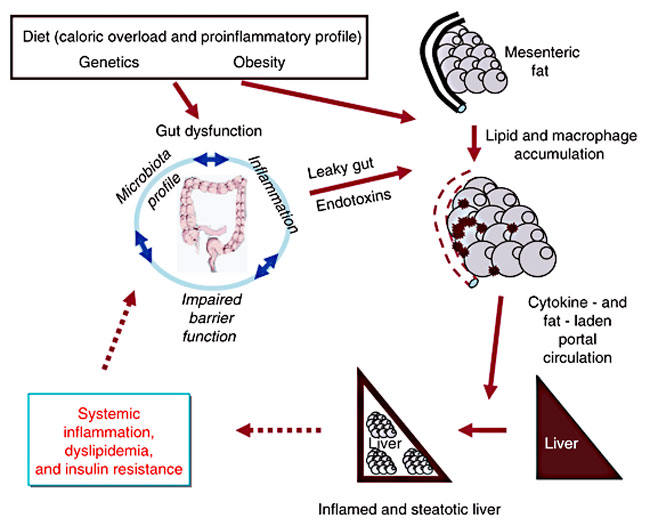Visceral Adipose Tissue (VAT), abdominal fat that is located deep inside the abdominal cavity, can have a devastating effect on our gastrointestinal health and increase our risk of various GI conditions.
As VAT is tucked between such organs as the stomach, liver, intestines, and kidneys, it may put undue pressure on those organs, interfering with the movement and function of the gastrointestinal tract. In addition, it may be a source of inflammatory hormones, cytokines, and chemokines. VAT is also known to increase the rate and severity of several gastrointestinal issues and diseases, such as:
- Gastroesophageal reflux disease, or GERD
- Small intestinal bacterial overgrowth, or SIBO
- Intestinal permeability
- Irritable bowel syndrome, or IBS
- Inflammatory bowel disease
- Diverticulosis/diverticulitis
- Non-alcoholic fatty liver disease
- Pancreatitis
- Colon/colorectal cancer
Increased intra abdominal adipose tissue can impede the motility of the GI tract, interfering with peristalsis, a wave-like coordinated movement of the GI tract which results in what we believe is the “sweeping” of bacteria and the movement of food. The intra abdominal fat also creates stress or pressure on the tract, which can negatively influence valves, such as the lower esophageal sphincter, and can result in increased esophageal reflux or malfunction of the lower ileocecal valve, causing increased buildup of bacteria in the small intestine, which should not occur. This increased “pressure” has also been implicated in the development or worsening of hiatal/diaphragmatic hernia and intestinal diverticula.
The inflammatory nature of Visceral Adipose Tissue (VAT)
As we become increasingly aware of the role of the inflammatory nature of VAT, we have learned that its impact is not only on cardiometabolic health, but also on the lining of the GI tract and is implicated with an increase in permeability (leakiness!) of the tract and a negative influence on microbiome dysbiosis.
As a physician, working with patients with high levels of VAT requires a delicate approach, as it produces a predicament:
Increased VAT = increased inflammation, which influences gut permeability and changes in the microbiome, which causes more systemic inflammation = cardiometabolic dysfunction and leads to more issues with the gastrointestinal tract.

When it comes to recognizing and testing for visceral adipose tissue levels, waist circumference acts as a surrogate marker. The ideal way to measure VAT levels is through imaging (which may be invasive and/or expensive) or in a physician’s office via bioimpendance analysis. As early diagnosis and prevention are key to the future of your health, discuss VAT with your doctor and inquire about testing.
Worth Reading
Altomare, Annamaria, Asencio, Laura Maria Trillo, Balestrieri, Paola, et al., Role of Overweight and Obesity in Gastrointestinal Disease, MDPI/2019
American Association for Cancer Research, Visceral fat causally linked to intestinal cancer, Science Daily/2013
Caterson, Ian D., Denyer, Gareth S., Holmes, Andrew J., et al., Role of the Gut in Visceral Fat Inflammation and Metabolic Disorders, Wiley Online Library/2012
Fialho, A., Fialho, A., McCullough, A., et al., Higher visceral to subcutaneous fat ratio is associated with small intestinal bacterial overgrowth, NMCD/2016
Han, Kyung Su, Kim, Byung Chang, Kim, Hyun Bum, et al., Abdominal Visceral Adipose Tissue Predicts Risk of Colorectal Adenoma in Both Sexes, Clinical Gastroenterology and Hepatology/2010


